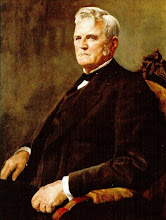Thursday, December 3, 2009
John's Later Life
He sent for his family in late 1838, and his family embarked on the six-week journey to Grand Detour. John made his own company and made more steel plows. He moved his operation to Moline, Illinois in 1848. Within a couple of years, John's production was 1600 plows a year. He later passed over management of the business to his oldest surviving son, Charles. In the 1850s John became interested in politics and agreed to be chairman of the county convention. In 1865, his wife, Demarius died. The next year, John traveled to Vermont to marry Demarious' sister Lucenia. In 1873, he became the 2nd mayor of Moline. When his two year term was up, he and his wife frequently visited Vermont. He died on May 17 1886, at 82 years old.
Difficultys of Farmers in Vermont
John soon heard frustration from Vermont Farmers, who weren't able to break the tough soil. Their cast-iron plows performed poorly in the Midwest. The soil clung to the bottom of the plow and had to removed by hand every few steps. John had an idea for a plow that would perform well in the soil, a plow with a highly polished surface. In 1837, He spotted a broken sawblade in the corner, he then created the worlds most successful steel plow.
Grand Detour
A former employer of John's settled in Grand Detour, when Easterners came west looking for a new start. The man enticed John with stories of the flat plains. What made up John's mind to leave was in November of 1836, when John owed $78.76. He decided to leave his family behind and head for Illinois, then retrieve his family once he had money. He left his family of a pregnant wife and four children. With just $73 he made the several week trip to Grand Detour. Once he arrived, he rented land and built a blacksmith shop.
Blacksmith Work Hard To Find
John and his steadily growing family moved from town to town searching for work, for the next 10 years. Due to the many blacksmiths in the area, competition for work increased. John, at one point, borrowed money to buy land and build a blacksmith shop, only to have fire destroy it, twice. This forced him to sell the property.
Becoming a Blacksmith

Deere preformed a number of blacksmith duties , such as shoeing horses, producing pots, and others. Furnishing the ironwork for stagecoaches and mills was one of the most common blacksmith work of the time. While he worked, he met Damarius Lamb, who attended the boarding school in Middlebury. They were married in 1827. John was 23 at the time.
Deere's Apprenticeship

At 17, in 1821, he left home to become a blacksmith apprentice to a blacksmith with a notable reputation in Middlebury, Captain Benjamin Lawrence. He was paid $30 the first year, and an additional $5 for each of the remaining years. He received a room and a set of clothes. In 1825 Deere completed his apprenticeship, and moved on to journeyman possitions where he improved his skills.

John Deere's Childhood
In 1804, John Deere was born. He was born in Rutland, Vermont on February 7th. At four years old, his father got lost at sea, and his mother, Sarah Deere, was left to raise five children. He received a simple education due to his family's lack of money. Since he was intrested in becoming a blacksmith, after school he would watch the blacksmith work. He took a job in his early teenage years, where he ground bark for small pay. He took this job to help out his mother, of this, his mother didn't know.
Subscribe to:
Comments (Atom)




_00.jpg)
